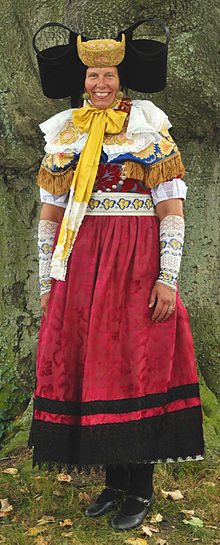Traditional costume club

A traditional costume association is an association that is dedicated to the practical maintenance and care of traditional costumes. Members are encouraged to local or regional costume to wear as often as possible and original and its expressed local ties sociable to enliven ( Customs ).
A common distinction is made between:
- Mountain costumes (conservation) associations; mostly abbreviated as GTEV
- (Homeland and) national costumes (conservation) associations; mostly abbreviated as VTV or HVTV (sometimes also TV)
history
Originally, traditional costumes were generally understood to mean "wearing" clothing or the "worn" clothing itself. The rural costume, like urban clothing, was subject to changes in fashion. At the beginning of the 19th century there was a real enthusiasm for traditional costumes at the Bavarian court, but also in Vienna . By Joseph Hazzi from Abensberg the first detailed description of the native costumes of the various dishes. In 1830 the archivist of the Bavarian Estates Assembly, Felix Joseph von Lipowsky , brought out a "Collection of Bavarian National Costumes". State authorities tried again and again to maintain the national costumes. So on June 1, 1853 with the letter of the presidium of the royal government of Upper Bavaria to "raise the national feeling, especially the national costumes". On April 4, 1859, the "Gemüthlichkeit" society was registered in Miesbach , the forerunner of the Miesbach traditional costume association founded in 1884. Around 1883 the teacher Josef Vogl in Bayrischzell also campaigned for the preservation of the old costumes and local customs. On August 25, 1883, together with other young boys, he founded the first "Mountain Costume Conservation Association". In 1890 at the suggestion of Thomas Bacher in Bad Feilnbach the Gauverband I founded the first umbrella organization of Trachtenvereine.
For a long time, traditional costume clubs were viewed critically on the part of scientific folklore . An example of this is the following statement by the Styrian university professor and costume researcher Viktor von Geramb , who acknowledged the local ties and the enthusiasm of the club members, but strongly objected to the practical work of the clubs:
“The basic mistake that we see in them is that the clothing is very often not seen and treated like a living costume, but rather like a club uniform. Yes, it is not uncommon for the individual garments not to belong to those who wear them, but to be the property of the association. Very often they do not match the face, the age or the shape of the wearer. Many clubs jealously watch over the fact that all members appear dressed in the same way, down to all the little folds and buttons, that is to say in uniform. This, however, [...] completely contradicts the essence of a living costume, which, unlike the uniform, must rather be well adapted to the level of life of its wearer, the seasons, the circumstances of the time, that is, varied, supple and yielding to the nature of the wearer. The contradiction with the laws of the folk costume often leads to the fact that one encounters ugly caricatures at the parades of the costume clubs [...] which destroy the joy of the sight and insult the dignity and honor of the folk costumes. "
Umbrella organizations
Traditional costume associations are very often grouped together in umbrella organizations. Probably the largest of its kind is the Bavarian Costume Association .
Germany
The Bavarian Trachtenverband and the other national costume associations in Germany are united in the German Trachtenverband (DTV) , which is based in Munich and has its office in Wechmar , Thuringia . It has about two million members in about 2000 clubs in ten federal states. It has been headed by Lord Mayor Knut Kreuch from Gotha since 2002 .
Austria
In Austria, many traditional costume associations are grouped together in the Federation of Austrian Traditional Costume Associations. In 1891 the traditional costume association “Alpinia”, which still exists today, was founded in Salzburg as the first Austrian traditional costume association. Note is the Bavarian influence that this club belongs not only to the National Association Salzburg, but also a member of the Bavarian district federation I is.
Switzerland
In Switzerland, many traditional costume associations are grouped together in the Swiss traditional costume association .
Individual evidence
- ↑ Viktor von Geramb / Konrad Mautner: Steirisches Trachtenbuch. Vol. II. Verlag Leuschner & Lubensky, Graz 1935, p. 572
